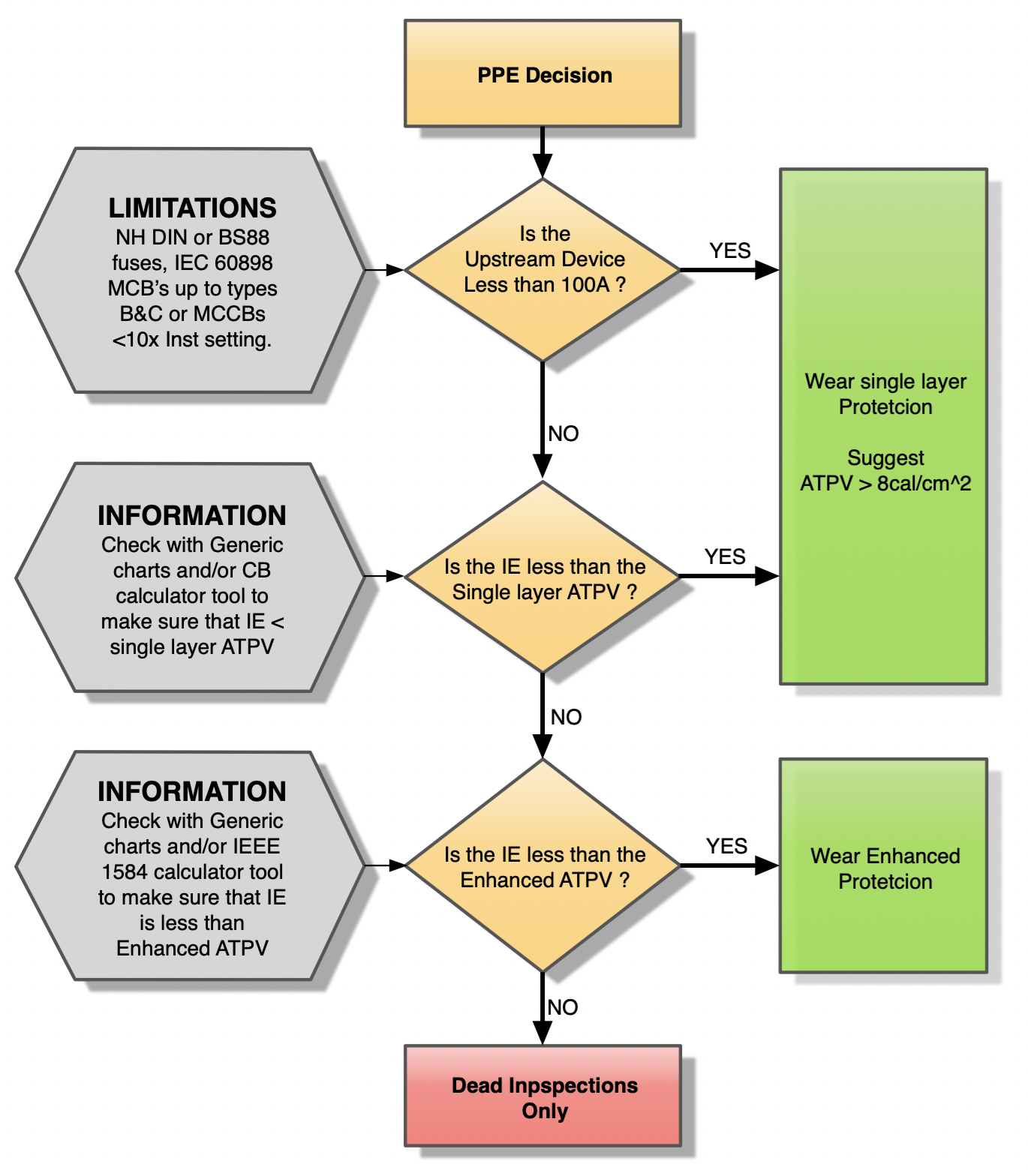The working distance can be added to this and with care there should be no reasons to be any closer than 600mm for inspection work. The usual working distance is 450mm for live work at 400 volts so, this increase in distance will result in a reduction of incident energy level of about a third. (This is given for illustrative purposes only and will require validation for the particular site conditions) For the remainder of inspections, the calculators will allow a quick estimation of the actual incident energy level. By this time, the prospective short circuit current will be known, making this process easier to adopt. For all other instances, do not take risks, and always arrange for a shutdown if necessary.
The flow chart in figure 8.2 should assist in arriving at the correct arc rating for the task of inspection.

Figure 8.2
Finally, do not forget the other risks such as electrical shock. If there is any risk of contact with live parts, which I would hope would be extremely small, then it may be necessary to provide insulating gloves and mats.
Working at height. If access is required for inspections at height, then this will need to be risk assessed. Whilst there may or may not be rules for access equipment onsite, the use of client’s own equipment needs careful consideration. This will always be a collaborative approach and the operation of hoists or scissor lifts by untrained personnel must be avoided. I mentioned the addition of a high-resolution camera to the “Tools for the Job” earlier and a zoom lens has allowed me to read equipment labels from the ground. For example, I have been able to get information from nameplate data from high level busbar trunking systems without having to arrange for access equipment.
8.2 Supply Source Data
8.2.1 Source Short Circuit Current Data and the Characteristics of Supply
Collecting data from the electricity supplier or third-party supplier in respect of the characteristics of supply can sometimes be seen to be extremely challenging particularly in respect of obtaining a realistic estimate of the available fault current. This is, however, the starting point for any arc flash risk assessment whether it be for a whole complex network supplied at high voltage or for an individual low voltage switchboard. Best practice dictates that we can obtain the required information by enquiry, calculation or measurement. There may be a case to adopt all three methods depending upon the complexity of the project, but the overriding consideration must always be confidence in output from any risk assessment.
8.2.2 Enquiry
Where we need to ask for the characteristics of supply this is usually from a public electricity company or maybe a third-party supplier.
Fundamental facts that you should know about the information from an electricity supplier.
- There is sometimes an obligation on electricity supply companies to provide the maximum prospective short circuit current. This is very specific in most supply agreements and often a legal duty. The problem is that the definition of the maximum prospective short circuit current, is often the theoretical design capability of the connecting cables and switchgear and is unlikely to be the fault level that appears at a connected customer’s supply terminals.
- The electricity supplier does hold all the information that you will need to undertake an arc flash risk assessment. In other words, as well as knowing what the maximum prospective short circuit current is, they will know what the actual or realistic prospective short circuit current is. The tricky bit is being able to speak to a person within the organisation who is knowledgeable on the subject.
- If the electricity supplier changes the characteristics of supply, then this can affect the output from any calculations.
- There is a fundamental shared objective for electricity supply companies to cooperate across operational boundaries in respect of safety. A supply company can do things that can affect the safety of connected companies and connected companies can do things that can affect the safety of supply company operatives.